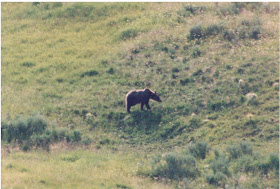I have only had the fortune of seeing a wild grizzly bear once in my life, in the Hayden Valley in Yellowstone National Park. It was across a river and far away - which was probably a good thing, because they can be very dangerous. I know someone that was mauled and almost killed by a grizzly while jogging in Teton National Park years ago. The pictures I have are not very good, but they're all I've got.
 This closeup of the previous picture at least gives the outline of this amazing animal.
This closeup of the previous picture at least gives the outline of this amazing animal. I've never done any backcountry hiking in Yellowstone and hope, perhaps someday, to get that opportunity. However, I have deep respect for the grizzly and don't have much desire to get much closer to one than this.
I've never done any backcountry hiking in Yellowstone and hope, perhaps someday, to get that opportunity. However, I have deep respect for the grizzly and don't have much desire to get much closer to one than this.Grizzly bears, now extinct in California, were once common in the San Bernardino Valley and Mountains.
Addison Pratt:
On December 20, 1849, Addison Pratt of the Jefferson Hunt wagon company noted, as they left Cajon Pass and entered the San Bernardino Valley: “The hills [were] covered with s[c]rub oak, that afford[ed] an abundance of acorns.” The acorns “invite[ed] the gri[zz]ly bears out of the mountains, as [they] saw frequent excavations made by [grizzlies] and several skulls of monstrous size.”[1]
Isaac Slover:
Isaac Slover, who hosted some of the 49ers that entered the San Bernardino Valley, was known for his love of grizzly hunting. Judge Benjamin Hayes noted that while hunting with Slover in the summer of 1850, they found grizzly tracks within a half mile of Slover’s home at Agua Mansa.[2] On October 14, 1854, Slover went hunting with James A. McMinds up Cajon Canyon. Near the Lower Narrows and Blue Cut, they entered into Lone Pine Canyon and traveled up to near its head. Slover found bear sign and followed it up a small side canyon, now known as Slover Canyon (but incorrectly identified on U.S. Geological Survey maps as Stover Canyon). The October 19, 1854 Los Angeles Star reported:
They met a very large [grizzly] bear and supposed they had killed it. On approaching near…they found that it still breathed. Whereupon Mr. Slover dismounted and was creeping around a bush to get a fair view before shooting, when the bear jumped upon him, breaking his right thigh in two places, badly crushing the bone, also biting a piece out of his left thigh and severely wounding him in the left side and head. McMinds fired, and the bear left Slover and chased McMinds a few yards, but immediately returned and laid down within five or six feet of Slover. McMinds afraid to shoot again, lest it should seize Slover, crept up and carried Slover off some distance, and put him on his mule…a quarter of a mile.
Slover was unable to go on, so McMinds went for a relief party. Slover died before the relief party could get him out of Cajon Canyon.[3]
Benjamin Wilson, the owner of Rancho Jurupa, indicates that in the fall of 1844, one of his ranchmen reported that a grizzly had been close to the ranch house and killed one of the best milk cows. Wilson took Evan Callaghan with him to hunt for the bear. They split up to try to find the bear, Wilson following some tracks leading away from the cow carcass that “went under an elder bush, covered with wild vines.”
Thinking the bear had passed out on the other side and going around the bush myself, I became entangled in another bush, in that condition the bear rushed from under his cover and bounced on behind me, bringing both the horse and myself to the ground; he bit me on the right shoulder into the lungs, and once in the left hip. By this time my dogs came up and the bear left me.”Wilson was carried home and eventually recovered, but “I still carry on my shoulder the marks of that bear’s tusks, in the form of a large hole, which can hold a walnut.”
In the summer of 1845, at the request of Governor Don Pio Pico, Wilson took some soldiers to pursue Indians that had been raiding ranches. After arriving at what is now known as Baldwin Lake, near Big Bear Lake, he noted that “the whole Lake and swamp seemed alive with bear.” 22 Californios went out in pairs and each pair “lassoed one bear,” for a total of 11 bears at one time.[4]
[1] Hafen, LeRoy R. and Hafen, Ann W. Journals of Forty-Niners, Salt Lake to Los Angeles: With Diaries and Contemporary Records of Sheldon Young, James S. Brown, Jacob Y. Stover, Charles C. Rich, Addison Pratt, Howard Egan, Henry W. Bigler, and Others, Glendale: Arthur H. Clark. 1954, p. 107
[2] Beattie, George William and Beattie, Helen Pruitt, Heritage of the Valley: San Bernardino’s First Century, Pasadena: San Pasqual Press 1939 (Heritage of the Valley), p. 24
[3] Heritage of the Valley, p. 26-27[4] Wilson, Benjamin David, “Benjamin David Wilson’s Observations On Early Days in California and New Mexico,” Historical Society of Southern California: Annual Publication (19__), 74-__, p. 87-89


Pictures of black bear is good and I like to see these bears. We offer alaska bear tours. book now.
ReplyDelete